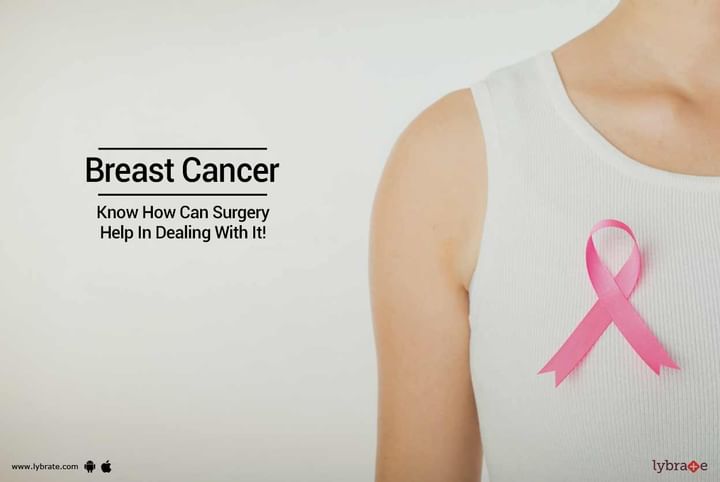Breast Cancer - Know How Can Surgery Help In Dealing With It!
Breast cancer is usually genetic in nature and it may affect women whose mother or grandmother may have suffered from the disease. This disease may start from the inner portion of the milk duct, in which case it is called ductal carcinoma. In case the cancer initiated through the lobules, it is called lobular carcinoma. In order to find the existence of the disease on a timely basis, it is imperative to get a regular screening done. This can also prevent the disease and its spread. Read on to find out more about symptoms and breast cancer screening methods.
Symptoms:
Breast Cancer does not usually have any symptoms during its early stages. As the development progresses, the following symptoms can be noticed:
1. Swollen armpit
2. Tenderness or pain in the breast
3. Noticeable indentation or flattening of the breasts.
4. Changes in the contour, size, temperature or texture of breasts
5. Changes occurring in the nipple like nipple dimpling, retraction, itching, ulceration or a burning sensation
6. Abnormal discharge from the nipple which might be bloody, clear or of another color
7. A region that is noticeably different from other areas on either breast
How screeing can be done?
Physical examination -
The doctor will, first of all, carry out a physical examination. This is due to the fact that breast cancer is not a mere existence of the lump. The various changes in the breasts as discussed above, especially dimpling of the breasts and pulling of the nipples, can point at the beginning of the disease, which must be tackled so as to prevent the full-fledged onset of the same. During this kind of clinical breast exam, the doctor will also show the patient how to conduct the test on her own every few weeks.
Mammogram -
This is essentially an X-Ray of the breasts and is usually carried out for women who have been facing consistent symptoms or even for those who are going through menopause. This kind of test should not be done too frequently as it can expose the patient to the risk of breast cancer, in case she does not already have the problem. This test is usually carried out with the help of a mammogram machine that will give a reading once the breasts are placed on the metal plates.
Breast MRI -
Magnetic resonance imaging (MRI) test seeks to create pictures of the area of the body in question with the help of radio waves. This is usually conducted for those patients who already run a high risk of breast cancer due to a family history of the same.
Treatment:
The type of treatment recommended by the doctor depends on the following:
1. Type of breast cancer
2. Size of tumor
3. Presence of receptors for certain type of hormones
There are some treatments that can utilized to destroy or remove the disease from within the breast and tissues such as lymph nodes that are nearby. They include:
Surgery options -
- Lumpectomy: This is a procedure wherein the surgeon cuts the tumour and removes some of the surrounding healthy tissue in order to ensure that cancer does not spread to the healthy cells after the surgery. This procedure is applicable for small tumours.
- Mastectomy: This is a procedure in which all tissues of the breast are removed. This includes lobules, fatty tissue, ducts, areola, and nipple. In a skin-sparing mastectomy, all of the breast skin, except the nipple and the areola, is preserved, which makes the reconstruction process easier.
- Sentinel node biopsy: Since the sentinel lymph nodes are the first place that cancer is likely to spread, a doctor might suggest a sentinel node biopsy if cancer has spread to the lymph nodes. If no trace of a cancer cell is found in the nodes, it is unlikely that any more nodes need to be removed.
- Removal of breasts: Many women who have cancer in one breast often choose to remove both the breasts in order to avoid the risk of cancer spreading. While a family history of breast cancer can greatly increase the chance of breast cancer in a woman, statistics show that most women who have cancer in one breast do not develop cancer in the other one
- Radiation: This is a process where a high-powered beam of energy is directed at the cancer cells to kill them. This method is often used after a lumpectomy. Radiations are of two types—external beam and brachytherapy. Some side effects of this treatment include fatigue, hair fall, loss of appetite and rashes.
- Chemotherapy: Chemotherapy is the treatment of cancer by cytotoxic and other drugs. This is often recommended by doctors when there is a good chance of the cancer cells spreading to other locations of the body. This form of treatment is often recommended before the surgery to shrink a tumour or restrict the growth of cells.
- Hormone therapy: Hormonal therapy is used to treat cancers that have hormonal sensitivity. They can be used before or after the surgery in order to ensure that cancer does not reoccur. Some of the treatment methods in this section include medication that restricts hormones from getting attached to the cancer cells, medications that restrict the body to produce oestrogen post-menopause and a medication that destroys cancer receptors.



+1.svg)
